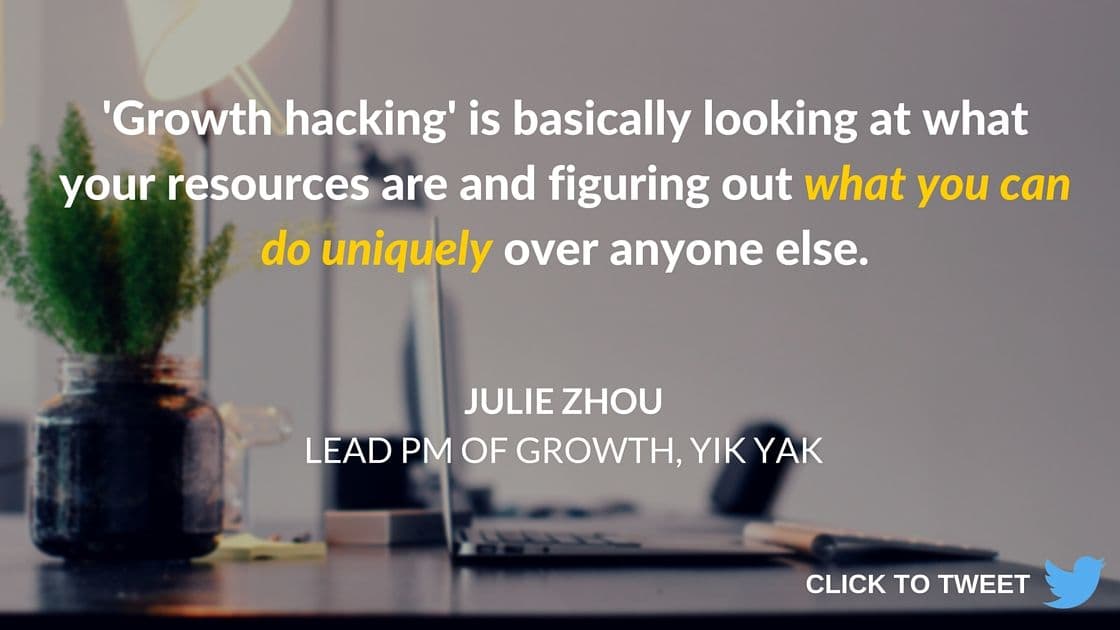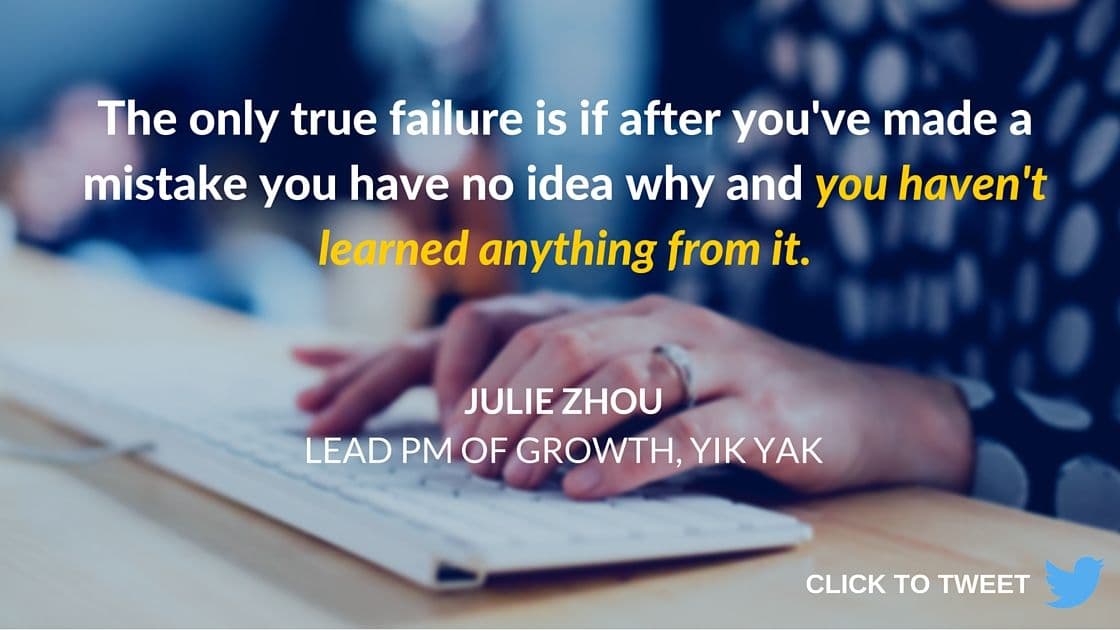What It Means to Be a ‘Growth Hacker’ According to Julie Zhou
This month we talked to Julie Zhou, Lead Product Manager of Growth at social media app Yik Yak.
Today we’re excited to share our second Datamonster of the Month story. This series is our way of spotlighting product and growth experts who have made data a central part of their success. Through their stories, we hope to empower other industry professionals with proven analytics strategies and advice for leveraging analytics across their organizations. We select our Datamonsters based on the impact they have at their respective companies. This ranges from how these individuals enable their entire organization to be data-informed to how they leverage analytics to make meaningful product and marketing decisions. Our Datamonster stories will be shared on our blog at the start of the month, and we’ll chat with each Datamonster during a live webinar called “Datamonster Dialogues.” This month I sat down with our May Datamonster Julie Zhou, Lead Product Manager of Growth at social media app Yik Yak.
Growth hacking from Google to Yik Yak
The first time I really understood what ‘growth’ was and why it mattered was when I heard Julie Zhou speaking at Growth Clinic, just one week after I had started at Amplitude. Since then, I’ve heard her speak at several different panels, and one thing stuck with me. Few people describe and embody growth hacking as well as Julie Zhou. “Growth, at the end of the day, is what marketing always should have been–a completely integrated strategy for company growth that combines the best of marketing, product, design, engineering, and analytics,” she said at one point during our conversation. When I asked Julie how she started her career in growth, she didn’t hesitate. “I’ve done growth my whole career, but only realized there was a special name for it recently,” she said. In fact, Julie approached growth from two complementary directions, from both a marketing and a product standpoint.
Learning the ‘science of marketing’ at Google
Julie graduated from Harvard with a degree in Economics. From there, she said, “Marketing was a natural fit for me.” She started out doing both B2B and B2C product marketing at Google, working on everything from Google Adwords, Google Maps, and Android OS. It was at Google where Julie experienced first-hand the importance of being data-driven in all aspects of her job. “At an engineering-driven company like Google, marketing was the odd one out,” explained Julie. Google had been growing well on its own, organically reaching people about its product, without really any explicit outward-facing marketing. There was confusion around what the role of marketing was at a company like Google. “**It quickly became apparent at such an engineering-, logic-, and data-driven company like Google, marketing had to follow suit,” said Julie. “Everything you wanted to do needed to be backed up with data and all the results needed to be measured with data. From the beginning, there was always a science to marketing.” **
Growth hacking at Hipmunk
Julie then took her data-driven marketing mindset to Hipmunk, a consumer-oriented online travel startup, at which she was employee number 10. Hipmunk was a huge change from Google. Julie admitted that she had never really been in a situation where the resources she had to work with were so limited. “At the time I joined Hipmunk, we didn’t have anywhere close to the budget of our competitors,” Julie explained. “Traditional wisdom dictated that, you could only grow a travel company by spending your way to success–by owning Google AdWords, TV advertising, all of that. We didn’t have those resources.” It became clear that in Hipmunk’s earliest days, paid advertising wasn’t the ideal growth channel to double down on–but that didn’t discourage her.
“I started thinking, ‘Well, let’s approach this from a logical mindset. We can’t pay our way to the top with cash, so we need to find out what currency we do have. We need to find out what our competitive advantages are.”
Hipmunk may not have had the deep pockets of Google, but that was fine. They were a small and sexy company, and had all the energy and nimbleness that came with being an early-stage startup. Julie devised a plan to pitch to the big wigs–Google, Apple, Facebook, Amazon– and secure promotions with them, telling them and showing them, with Hipmunk’s product roadmap, that they were the best travel app out there. With that, she was able to secure consistent promotions According to Julie, they grew, through the sheer power of their personality. “I didn’t realize that what I was doing was called ‘growth hacking,’ but I guess that’s what it was,” she added. “It’s basically looking at what your resources are and figuring out what you can do uniquely over anyone else.”

Product Management at Yik Yak
At Hipmunk, Julie’s job was growth through the lens of marketing; it was all about spreading brand awareness and acquiring more users. After she joined the team at Yik Yak, however, Julie started looking at growth through another lens: product. “Growing Yik Yak was more about, ‘Okay, everyone has heard about us, how can we continue to get them to become more engaged with the product?’” says Julie. Yik Yak already had brand recognition and power users. Taking the company to the next level meant understanding their users and growing the product into something they’ll come back to over and over again.
Different flavors of product managers
Just as you can look at growth from the lens of marketing and product, you can look at product management itself from multiple lenses. Julie grew into her role organically, transitioning from product marketing, to growth marketing, to product. For people looking into career in growth and product management, Julie says to consider the different flavors of it. “Some product managers need to be extremely technical. Others need to be less so,” she says. “I won’t say that you have to go and learn a programming language and be able to build your own apps in order to be a product manager. That’s just not true.” In terms of the “technical vs. non-technical product manager” debate, it really depends on the product itself. When the company is the function of its product, like Google, there’s a considerable engineering challenge involved in growing the company as a whole, growing to be the best search engine in the world. For a technically sophisticated product, it would critical to have a technical product manager. “For companies like Yik Yak, the power of the company comes from the people who use it, the network you’re able to build from it. It’s about the operations used to perfect and optimize and get as many people on the platform as possible,” said Julie. Julie was driven to product management by her fascination with software and mobile apps, but when she started out, she herself didn’t have any experience in programming, aside from an online course in C. It’s more important for her to have a solid understanding of how the product is built, to be able to have intelligent conversations with the engineers she works with, rather than acquire the skills to build the product herself.
“Regardless of what type of product manager you want to be, you have to have empathy for your users – and that includes your engineers, marketers, leaders as well as your actual end users.”
Progress
When I asked Julie to describe her job at Yik Yak in one word, her answer was ‘progress.’ Progress describes the day-to-day responsibilities of growth folks pretty accurately. Every single day, they ask themselves if they’re better off than the day before, if they’ve improved certain metrics or KPIs. Even failure, according to Julie, is progress, when you can learn from it. “The only true failure,” says Julie, “is if after you’ve made a mistake, you have no idea why and you haven’t learned anything from it.” In her role as a product manager of growth, Julie continues to have a data-driven approach to everything she does. This means constantly monitoring KPIs, running experiments, figuring out what’s working and what’s not, and driving toward Yik Yak’s core metrics, using analytics.

Using Amplitude to make progress at Yik Yak
Yik Yak uses Amplitude to get a handle on its progress. Specifically, says Julie, “We use Amplitude to understand how people are using the features that we’ve launched. We try to see if there are certain behaviors that our most engaged users do that, if we could drive our more casual users to also do, would then move them into higher brackets of engagement.” Yik Yak pays particular attention to what users do within the first week of downloading the app. They’ve found that the way users behave days after they download the app, tends to be very predictive of the “type” of user they turn out to be later. That’s why so much of their effort is dedicated toward building a flawless first-week experience that encourages certain types of behavior in order to increase the chances of users being retained long-term. “I’ve used pretty much every single analytics platform out there, from third-party to internal,” Julie said, when I asked her about choosing Amplitude for her analytics needs. “The sheer flexibility that Amplitude gives, I don’t think is matched by any other platform–From the fact that you can directly query the database with SQL to the fact that you can create a cohort from literally everything, to the fact that you can look at a graph, click on a point and be like, ‘Who are the users that did this? Tell me more about them,’ and draw conclusions about what happened.” Yik Yak cares much more about long-term engagement and whether they can get that level of engagement to increase over time versus vanity metrics like downloads; and that’s what Amplitude helps them investigate.
**Julie Zhou, Product Manager and Growthmaster **
Throughout our conversation, I could tell that ‘growth hacking’ was a term that Julie and other growth experts like Instacart’s Fareed Mosavat were skeptical of. “It’s great that more attention and excitement is being built around this field, but kind of sad that at the same time there’s been a lot of misinformation about how this is a brand new discipline or that there’s one weird trick or a silver bullet that will get you to hyper-growth,” Julie said early on in our conversation. The fact of the matter is that the growth Julie achieved from her experience at both Hipmunk and Yik Yak was born out of hard work, creative thinking, and a data-driven mindset. That’s probably why you’ll see Julie refer to herself more often as a ‘growthmaster’–as was her title at Hipmunk– over ‘growth hacker’ any day.

Archana Madhavan
Senior Learning Experience Designer, Amplitude
Archana is a Senior Learning Experience Designer on the Customer Education team at Amplitude. She develops educational content and courses to help Amplitude users better analyze their customer data to build better products.
More from Archana




